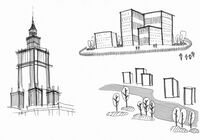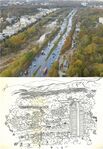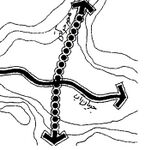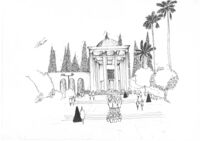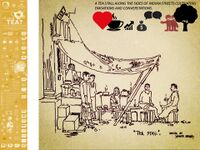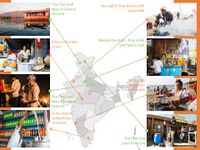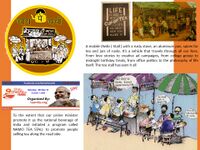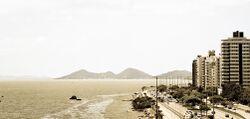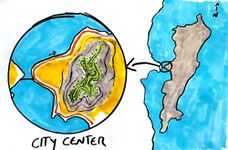LED Seminar 2016 - Landscape Symbols Reflection Group I
Landscape Symbol 1- Warsaw, Anna Janus
Representations and analytical drawings
in addition to your initial visual please add two further analytical drawings of your symbol
Reflections
Please write a 250 words text reflecting on the following questions, you can also take ideas from your group members into account
- How and why did the symbols you identify appear in your landscape?
- Did their meaning change along with socio-political, economic, environmental or cultural changes in your region, or country?
- What do these symbols mean to you today? Are they meaningful to more than just one cultural group? Are they shared across cultures?
add your text here The Palace of Culture and Science, originally known as the Joseph Stalin Palace of Culture and Science, was built in 1955. It was a 'gift from the Soviet Union to the people of Poland', as a symbol of soviet power and city reconstruction. Over the time and generations sense of the building changed. For older people The Palace reminds about Polish history and problematic past. For young people it is just centrally located building, without any emotional charge. Many consider it as ugly piece of architecture that should be destroyed or covered by other constructions. For me it is a symbol of the past. It is a well organised, useful public building that combines different cultural facilities as theatre, museum, or cinema. It also carries many art pieces of Polish artists such as paintings, sculptures, as well as furniture and architectonical details. For many it is regarded as Warsaw landmark.
Landscape Symbol 2- Saeid Saadat
Representations and analytical drawings
in addition to your initial visual please add two further analytical drawings of your symbol
Reflections
Please write a 250 words text reflecting on the following questions, you can also take ideas from your group members into account
- How and why did the symbols you identify appear in your landscape?
- Did their meaning change along with socio-political, economic, environmental or cultural changes in your region, or country?
- What do these symbols mean to you today? Are they meaningful to more than just one cultural group? Are they shared across cultures?
After considering the topic the first thing that comes to my mind as a symbol was Garden which has rich and strong root in my country and culture, although I choose Garden I could not close my eyes on the Rivers with their importance and role in shaping the cities and designing the first landscapes by their streams. Rivers as dynamic element of the nature can deliver this message to us for reaching freedom and our goals we should not stand in place and get rotten we should move and pass the barriers to explore the life and environment. About garden I should admit that in general, the Persian Garden is formed on a symmetrical pattern encompassing mainly rectangular and square shapes. The nature of Persian gardening is based on equality and balance. This means that weights of green area is spread through out the whole landscape in order to make a balance. This agenda is emphasized by utilizing the streams along the garden. Not only the instinct of water is deriving the purity and cleanliness but it is feeding each green area equally. Moreover in gardens you can find the reflection of different nature's elements. After passing hundreds of years and changes in society and different policies we still can feel the importance and role of Gardens and River in Iran, however in some cases the culture of dealing with gardens had been changed due to changes among the society (for example some private gardens had been sold and they change to a public parks, or some private gardens are used by government for political meetings) and unfortunately in some cases Rivers got drought due to global warming and mismanagement of authorities.
Landscape Symbol 3- Tea Stall, Stuti Sareen
Representations and analytical drawings
Reflections
Tea is made both at home and outside in India. Outside the home, tea is most commonly and easily found at the ubiquitous tea stalls that dot just about every street in India. The tea stall has become a part of the urban landscape and a cultural institution, even celebrated as in the recent art exhibition titled “Chai Wallah and other stories” by the artist Vijay Gille.“Chai Wallah” is the Hindi title accorded to the man who runs the tea stall. To a backdrop of clanking pots and pans, biscuit munching, money rustling and the call of the chaiwallah, conversations flow...The local tea stall is home to rumours, news gossip.philosiphies stories, dreams, bulletins, fears, results, promotions, business and politics. And everyone moving on the Indian street pour out some and fill in some to this Indian tea admist the backgound of the tea stall.
Landscape Symbol 5- Florianopolis, Lucas Passold
Representations and analytical drawings
in addition to your initial visual please add two further analytical drawings of your symbol
Reflections
Please write a 250 words text reflecting on the following questions, you can also take ideas from your group members into account
- How and why did the symbols you identify appear in your landscape?
- Did their meaning change along with socio-political, economic, environmental or cultural changes in your region, or country?
- What do these symbols mean to you today? Are they meaningful to more than just one cultural group? Are they shared across cultures?
Florianópolis is a city well known across the country by its natural landscape, mostly because of the beautiful beaches. So the sea is totally associated with the image of the city, becoming a symbol. Since the city is an island, it is impossible to not notice it, but that doesn't necessarily mean that everybody who lives here sees the symbol in the same context. The vision of the seashore has changed along the times, coming from a place of trash disposal to become a place of leisure and human interaction. This new approach to the sea made the city invest mostly in these parts, adding value to the nearby land and expelling the bigger e poorest part of the population to the outskirts of Florianópolis. Sadly, the investments aren't good either, since they are made mostly with an infrastructure sense of providing good assets for cars (12 car lanes and 1 small pedestrian lane along the shore). The small remaining part along the shore gives only a small possibility for the people who live nearby to practice sports like running and biking. Somehow this landscape is becoming only a good symbol for the rich who has access to it, meanwhile this landscape is not a palpable symbol for the rest of the citizens who can only watch it from inside the bus on the way to work.
Group reflection
The symbol is an object with changing meanings over the period of time but it was observed that all these objects help there particular importance in the cultural and social context. Out of the 4 symbols as mentioned above, two of them were human creations into the landscape were as the other two were natural features of the landscape. May be in former times these symbols were introduced or perceived in a very fundamental way but now the also serve as a resource to new opportunities for the society, thus the importance is consistent.
